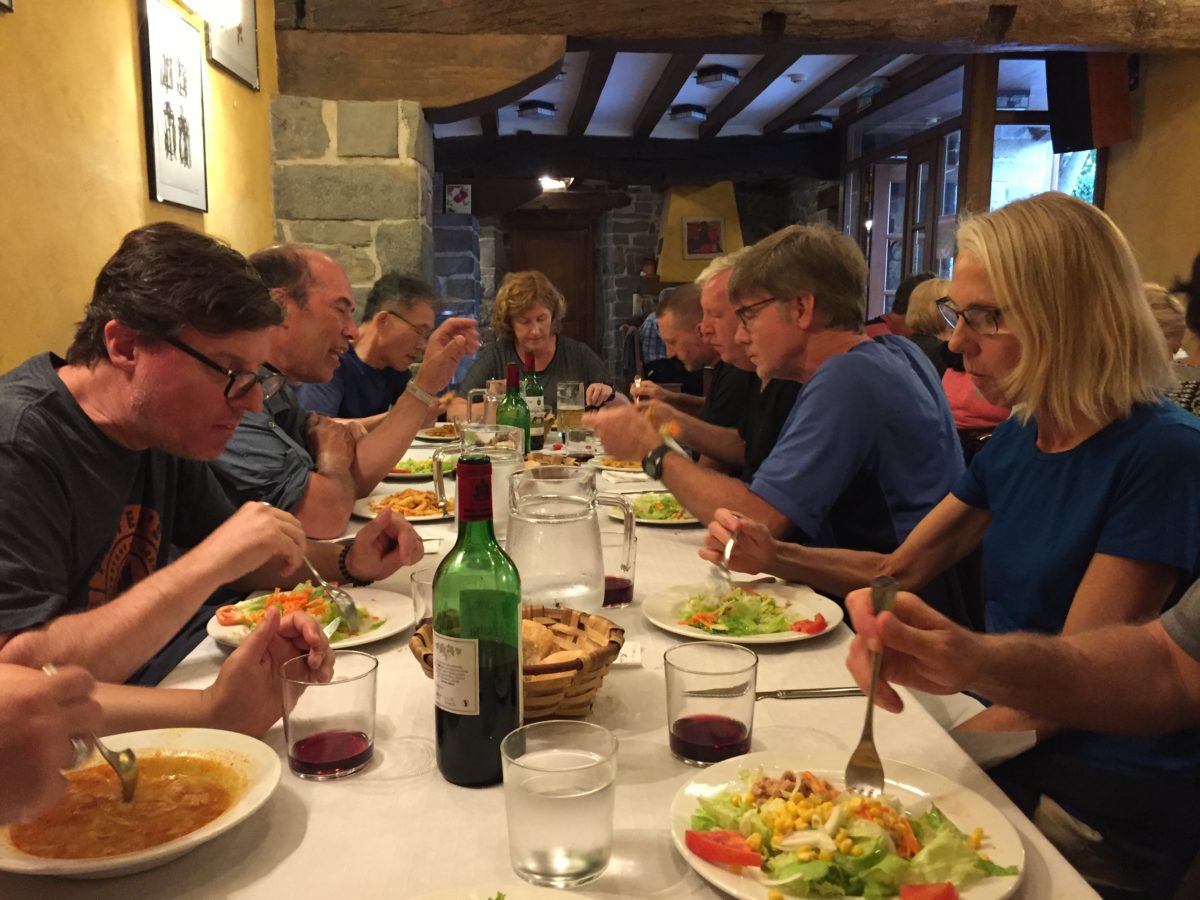Colors. Vibrant, fresh, appealing colors. Assorted textures and aromas. A feast for the senses.
That’s what we enjoyed on the Camino. Every day. And I’m not talking about the landscape.
I’m talking about food and meals. Especially dinner. Three courses nightly.
First things first—
Take a look at your lunch or dinner today. How many colors can you count in it? Reds, blues, dark greens. Purples or oranges, or both.
The healthiest diets include lots of colors, and usually six to eight simple ingredients. I thought I was doing a pretty good job of meeting these goals with my meal planning, but after eating on the Camino, I realized I wasn’t.
My meals were often boring and two or three-dimensional. And aside from our two-three times a week fish for dinner, it looked like the typical American plate:
Meat or protein focus surrounded by a small salad bowl side of salad, veggie, and grains, rice, or quinoa.
Scads of data is in, and the ugly truth is: a diet heavy on meat (including red, chicken, and pork) is deadly. But does that mean you have to take the leap to total vegetarianism to eat healthy?
No.
What you need to do is cut down on it. Way down. And I do mean w-a-y.
How much meat is enough?
No more than 3 oz. of it for any meal. And it’s even better if you can whittle that number down to 3 oz. of it for just one meal, like dinner.
The best choice, though, is to nix it for most of your meals and only consume it several times a month. Fish can be eaten more often.
We won’t go into the science behind it in today’s post, so, for now, you’ll need to take my word for it. But before you rant at your computer screen, or say, “No way will my husband give up his 6 oz. burger, Andrea!” let’s go for the baby steps. Starting with the statement I noted in this week’s Workout Wednesdays post:
“Start with the good and then weed out the bad.”
So how can you do that?
Applying the basics—
First, start by adding A LOT of variety to your meals. Tomatoes, carrots, onions, celery, garlic (garlic granules are actually the best way to go), spinach, leafy spring greens, power greens, kale, chard, romaine, roasted red peppers. Or broccoli and avocados. Crinkle cut sweet potatoes and hummus. Cucumbers, black-eyed peas, garbanzo beans (chickpeas), millet, quinoa and amaranth. Rolled oats, dried grapes, nuts, steel cut oats. Fresh grapes, oranges, bananas and pineapple. Apples of all colors, tart and sweet.
Then start assembling!
Select four or five ingredients for a LARGE salad or soup (like a carrot-ginger or butternut squash) as your first course. I’ll lay out two large dinner plates and spread mixed greens over each one. Sometimes it’s baby spinach alone (which I purchase in a bag or container), or a blend of power greens. (I’ve been avoiding Romaine lately due to the E. coli issue the United States has been experiencing with it.)
I’ll top the lettuce with fresh heirloom tomatoes, orange, red, dark red, or yellow or combinations. Organic, English or Persian cucumbers (yummy!), get added, and probably one avocado divided between the two of us. Sometimes carrot strips get sprinkled on, or garbanzo beans. You might add sliced strawberries for a sweet addition, but be careful about heavy-handedness with the dried fruit, like dried cranberries, which are all the rage right now. It’s too much sugar.
Top that with extra virgin olive oil and a little salt and garlic granules for the dressing. Or olive oil mixed with a little freshly squeezed lemon juice and salt. Sometimes I’ll add specialty salt, like Hawaiian, or Tai ginger salt. And when I’m growing fresh basil, I snip some leaves, roll them into little cigar shapes, cut and sprinkle that on the salad or blend it into the olive oil. Famous chef Julia Child said there was no reason to purchase salad dressing since it is so easy to make at home! Take her advice.
And voila! You have a substantial FIRST COURSE meal!
For the SECOND COURSE, make a ratatouille-like dish out of onions, carrots, celery, and eggplant in chicken broth. If you haven’t added garbanzos to your salad, consider adding them here. Or black-eyed peas (loaded with vitamins and protein). or white beans. Change the flavor by adding turmeric and ginger, powdered or root form. I sometimes make the base out of chicken broth, and add roasted red peppers I’ve pulverized in a blender or Bullet to add a little roasted sweetness. For thickener, I might add a little tomato paste, but not much.
BONUS: When you reduce your meat consumption, you’ll save a lot of money! Dollars you could use to purchase expensive organic fruits and veggies.
For the FINAL COURSE, or dessert, consider finishing off the meal with some figs or dried dates, or an orange. Or do as the French and top it off with assorted cheeses. Yum! Or skip the dessert altogether. Our family has never made dessert a must-have, so having dessert on the Camino everyday was an unusual treat.
And there you have it! A three-course meal that doesn’t take that long to make. Especially if you make sure you keep all of these fruit and veggie staples in your refrigerator or on your counter.
And if you do the smart thing and plate your meal before heading to the dinner table and put the remainder in a container in the refrigerator for the next day’s lunch or leftovers, you’ll be another step ahead!
When in Spain—
The Spaniards (at least the Northern residents) seem to love their meat, especially pork, and it was offered at every meal. But fish was plentiful. And the plate servings were substantial. So much so that you could get adequately full with the salad if you weren’t walking five to six hours a day.
So with all of that meat-eating, how does that country end up besting the United States by so many places in longevity?
Spain is tied for 4th on the list along with Australia. The United States showed up way down the list at 31. (The standings/rankings change only slightly depending upon what list you reference.)
So, what’s their secret?
After really observing the French and Spanish culture in the areas we traveled through, I think I hit on at least one significant game-changing factor, aside from the fact that the physical contrast between these Europeans and Americans was dramatic to us when we returned. The Europeans looked healthier, slimmer and happier, while the Americans back home looked fat, frumpy and unhappy.
Very unhappy.
Turning a meal into a social extravaganza!
Did you know that ½ of Americans experience loneliness? They feel lonely most of the time. And that loneliness can drive people’s diseases and increase the death rate by 50% percent. Yes, loneliness is that powerful.
What a shame. In a world where we’re “more connected” to one another than we’ve ever been we aren’t truly connected, and we suffer loneliness.
Did you know that having social connections is the #1 indicator of whether you will live a longer, happy life.
And that’s one of the most significant things we experienced on the Camino:learning to take the time to enjoy your meal with family and friends.
Something we’d always done when our boys were younger but had lost the art of doing.
Who really knows what the Iberian Peninsula residents do during their siesta times, but after those siesta hours they hit the streets—to shop for dinner ingredients and gather together to smoke (and smoke and smoke), enjoy a glass of wine and talk and laugh and talk and laugh and talk and laugh. Before dinner. While mom and dad socialized and snacked with friends, the kids wheeled around the squares on their scooters or booted soccer balls between one another.
They were building and nurturing relationships, around eating.
How different that is from so many Americans who throw together a meal without paying attention to its life-robbing ingredients, or open up bags of fast food containers and spread that out on the kitchen table for everyone to grab and wolf down farm style.
With text messages clicking back and forth between friends, and parents reading newspapers, watching the news, or chatting on their phones. Or the family meal is skipped altogether for sports practice, and everyone ends up eating alone, or in the car.
My younger son said the Italians enjoy meals the same way as the Spaniards. If so, it shows. Italy ranks #7 in longevity. (The World Health Organization—WHO—lists different rankings for men and women.)
Scientists now know that eating while socializing actually changes your physiology, for the better.
It has a huge impact on our well-being.
We seriously need to rethink how we do food and dining in the United States!
Applying it to Thanksgiving and Christmas—
With these two food-laden celebrations upon us, how can you put some fo this knowledge to work and turn over a new food leaf now without waiting for the New Year to grind it out?
Here are some changes to start this year:
- Buy a smaller turkey, so the meat isn’t the huge centerpiece of the meal.
- Provide several selections of veggies, with colorful choices.
- Have some cooked and raw vegetable selections.
- Provide the fixings for a big salad. (Turkey slices on a salad are delicious!)
- Keep any cream-based selections to a minimum.
- Provide alternative selections to the heavy (overly sweetened desserts).
- Set out good snacks, like grapes, nuts, cheeses, and berries for people to snack on before they eat.
- Don’t fill the house up with sweets and cookies, in lieu of healthful food.
And make sure your friends, co-workers, and classmates have a place to spend the day. Treat them like you would family.
Do as much preparing before the day as possible in order to reduce the stress of the day. And take joy in the preparing you do do on that day.
Make sure everyone chips in to help in some way, so no single person feels burdened and alone in preparing.
And try to stretch the meal out as much as possible, with the meal resembling more of a 3-course or more meal. Guaranteed all of you will eat less and feel better nourished and more satisfied!
So until next Friday, when we’ll talk more about keeping the Camino going back home, take some time for that alternative planning and food purchasing.
And try NOT to make Costco or Sam’s Club your go-to supermercardo!
Blessings,
Andrea
May you prosper in all things and be in health, just as your soul prospers (3 John 2).





